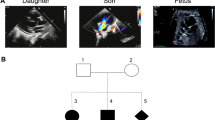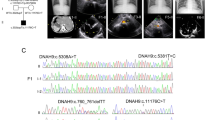Abstract
The establishment of left–right asymmetry is a fundamental process in animal development. Interference with this process leads to a range of disorders collectively known as laterality defects, which manifest as abnormal arrangements of visceral organs. Among patients with laterality defects, congenital heart diseases (CHD) are prevalent. Through multiple model organisms, extant research has established that myosin-Id (MYO1D) deficiency causes laterality defects. This study investigated over a hundred cases and identified a novel biallelic variant of MYO1D (NM_015194: c.1531G>A; p.D511N) in a consanguineous family with complex CHD and laterality defects. Further examination of the proband revealed asthenoteratozoospermia and shortened sperm. Afterward, the effects of the D511N variant and another known MYO1D variant (NM_015194: c.2293C>T; p.P765S) were assessed. The assessment showed that both enhance the interaction with β-actin and SPAG6. Overall, this study revealed the genetic heterogeneity of this rare disease and found that MYO1D variants are correlated with laterality defects and CHD in humans. Furthermore, this research established a connection between sperm defects and MYO1D variants. It offers guidance for exploring infertility and reproductive health concerns. The findings provide a critical basis for advancing personalized medicine and genetic counseling.
Similar content being viewed by others

References
Blum M, Ott T. Animal left-right asymmetry. Curr Biol 2018; 28(7): R301–R304
Pierpont ME, Brueckner M, Chung WK, Garg V, Lacro RV, McGuire AL, Mital S, Priest JR, Pu WT, Roberts A, Ware SM, Gelb BD, Russell MW; American Heart Association Council on Cardiovascular Disease in the Young; Council on Cardiovascular and Stroke Nursing; and Council on Genomic and Precision Medicine. Genetic basis for congenital heart disease: Revisited: A scientific statement from the American Heart Association. Circulation 2018; 138(21): e653–e711
Cui C, Chatterjee B, Lozito TP, Zhang Z, Francis RJ, Yagi H, Swanhart LM, Sanker S, Francis D, Yu Q, San Agustin JT, Puligilla C, Chatterjee T, Tansey T, Liu X, Kelley MW, Spiliotis ET, Kwiatkowski AV, Tuan R, Pazour GJ, Hukriede NA, Lo CW. Wdpcp, a PCP protein required for ciliogenesis, regulates directional cell migration and cell polarity by direct modulation of the actin cytoskeleton. PLoS Biol 2013; 11(11): e1001720
Park TJ, Haigo SL, Wallingford JB. Ciliogenesis defects in embryos lacking inturned or fuzzy function are associated with failure of planar cell polarity and Hedgehog signaling. Nat Genet 2006; 38(3): 303–311
Juan T, Géminard C, Coutelis JB, Cerezo D, Polès S, Noselli S, Fürthauer M. Myosin1D is an evolutionarily conserved regulator of animal left-right asymmetry. Nat Commun 2018; 9(1): 1942
Lebreton G, Géminard C, Lapraz F, Pyrpassopoulos S, Cerezo D, Spéder P, Ostap EM, Noselli S. Molecular to organismal chirality is induced by the conserved myosin 1D. Science 2018; 362(6417): 949–952
Saydmohammed M, Yagi H, Calderon M, Clark MJ, Feinstein T, Sun M, Stolz DB, Watkins SC, Amack JD, Lo CW, Tsang M. Vertebrate myosin 1d regulates left-right organizer morphogenesis and laterality. Nat Commun 2018; 9(1): 3381
Tingler M, Kurz S, Maerker M, Ott T, Fuhl F, Schweickert A, LeBlanc-Straceski JM, Noselli S, Blum M. A conserved role of the unconventional myosin 1d in laterality determination. Curr Biol 2018; 28(5): 810–816.e3
Alsafwani RS, Nasser KK, Shinawi T, Banaganapalli B, ElSokary HA, Zaher ZF, Shaik NA, Abdelmohsen G, Al-Aama JY, Shapiro AJOOAR, O Al-Radi O, Elango R, Alahmadi T. Novel MYO1D missense variant identified through whole exome sequencing and computational biology analysis expands the spectrum of causal genes of laterality defects. Front Med (Lausanne) 2021; 8: 724826
Huang H, Chen Y, Jin J, Du R, Tang K, Fan L, Xiang R. CSRP3, p. Arg122*, is responsible for hypertrophic cardiomyopathy in a Chinese family. J Gene Med 2022; 24(1): e3390
Xiang R, Fan LL, Huang H, Chen YQ, He W, Guo S, Li JJ, Jin JY, Du R, Yan R, Xia K. Increased reticulon 3 (RTN3) leads to obesity and hypertriglyceridemia by interacting with heat shock protein family A (Hsp70) member 5 (HSPA5). Circulation 2018; 138(17): 1828–1838
Gabriel GC, Young CB, Lo CW. Role of cilia in the pathogenesis of congenital heart disease. Semin Cell Dev Biol 2021; 110: 2–10
Li Y, Klena NT, Gabriel GC, Liu X, Kim AJ, Lemke K, Chen Y, Chatterjee B, Devine W, Damerla RR, Chang C, Yagi H, San Agustin JT, Thahir M, Anderton S, Lawhead C, Vescovi A, Pratt H, Morgan J, Haynes L, Smith CL, Eppig JT, Reinholdt L, Francis R, Leatherbury L, Ganapathiraju MK, Tobita K, Pazour GJ, Lo CW. Global genetic analysis in mice unveils central role for cilia in congenital heart disease. Nature 2015; 521(7553): 520–524
Klena NT, Gibbs BC, Lo CW. Cilia and ciliopathies in congenital heart disease. Cold Spring Harb Perspect Biol 2017; 9(8): a028266
Rosengren T, Larsen LJ, Pedersen LB, Christensen ST, Møller LB. TSC1 and TSC2 regulate cilia length and canonical Hedgehog signaling via different mechanisms. Cell Mol Life Sci 2018; 75(14): 2663–2680
Sironen A, Shoemark A, Patel M, Loebinger MR, Mitchison HM. Sperm defects in primary ciliary dyskinesia and related causes of male infertility. Cell Mol Life Sci 2020; 77(11): 2029–2048
Wang L, Bu T, Li L, Wu X, Wong CKC, Perrotta A, Silvestrini B, Sun F, Cheng CY. Planar cell polarity (PCP) proteins support spermatogenesis through cytoskeletal organization in the testis. Semin Cell Dev Biol 2022; 121: 99–113
Li X, Zhang D, Xu L, Han Y, Liu W, Li W, Fan Z, Costanzo RM, StraussIii JF, Zhang Z, Wang H. Planar cell polarity defects and hearing loss in sperm-associated antigen 6 (Spag6)-deficient mice. Am J Physiol Cell Physiol 2021; 320(1): C132–C141
Xu C, Tang D, Shao Z, Geng H, Gao Y, Li K, Tan Q, Wang G, Wang C, Wu H, Li G, Lv M, He X, Cao Y. Homozygous SPAG6 variants can induce nonsyndromic asthenoteratozoospermia with severe MMAF. Reprod Biol Endocrin 2022; 20(1): 41
Tu C, Cong J, Zhang Q, He X, Zheng R, Yang X, Gao Y, Wu H, Lv M, Gu Y, Lu S, Liu C, Tian S, Meng L, Wang W, Tan C, Nie H, Li D, Zhang H, Gong F, Hu L, Lu G, Xu W, Lin G, Zhang F, Cao Y, Tan YQ. Bi-allelic mutations of DNAH10 cause primary male infertility with asthenoteratozoospermia in humans and mice. Am J Hum Genet 2021; 108(8): 1466–1477
Wang R, Yang D, Tu C, Lei C, Ding S, Guo T, Wang L, Liu Y, Lu C, Yang B, Ouyang S, Gong K, Tan Z, Deng Y, Tan Y, Qing J, Luo H. Dynein axonemal heavy chain 10 deficiency causes primary ciliary dyskinesia in humans and mice. Front Med 2023; 17(5): 957–971
Saggiorato G, Alvarez L, Jikeli JF, Kaupp UB, Gompper G, Elgeti J. Human sperm steer with second harmonics of the flagellar beat. Nat Commun 2017; 8(1): 1415
Zhou L, Liu H, Liu S, Yang X, Dong Y, Pan Y, Xiao Z, Zheng B, Sun Y, Huang P, Zhang X, Hu J, Sun R, Feng S, Zhu Y, Liu M, Gui M, Wu J. Structures of sperm flagellar doublet microtubules expand the genetic spectrum of male infertility. Cell 2023; 186(13): 2897–2910.e19
Acknowledgements
The study was supported by the National Natural Science Foundation of China (No. 81970268), the Natural Science Foundation of Hunan Province (No. 2023JJ30781), and the Graduate Student Scientific Research Innovation Project of Hunan Province (No. CX20220315).
Author information
Authors and Affiliations
Corresponding author
Ethics declarations
Conflicts of interest Zhuangzhuang Yuan, Xin Zhu, Xiaohui Xie, Chenyu Wang, Heng Gu, Junlin Yang, Liangliang Fan, Rong Xiang, Yifeng Yang, and Zhiping Tan declare no conflict of interest.
The study was approved by the Ethics Committee of the Second Xiangya Hospital of Central South University, and the study was performed in accordance with the ethical standards stated in the 1964 Declaration of Helsinki and its later amendments or comparable ethical standards. Informed consent was obtained from all patients included in the study.
Rights and permissions
About this article
Cite this article
Yuan, Z., Zhu, X., Xie, X. et al. Identification of a novel MYO1D variant associated with laterality defects, congenital heart diseases, and sperm defects in humans. Front. Med. (2024). https://doi.org/10.1007/s11684-023-1042-6
Received:
Accepted:
Published:
DOI: https://doi.org/10.1007/s11684-023-1042-6



